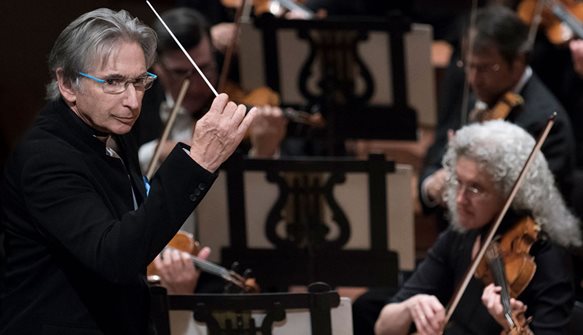
BIGGER THAN LIFE, AND FANTASTIQUE
Masterful Berlioz with a finger-bending Bartok
The San Francisco Symphony pulled out all the stops this week. Naturally, because Berlioz was featured as composer.
Often derided as an anachronism, Hector Berlioz (1803-1879) was in truth a figure far ahead of his time, a futurist in that he brought the romantic era in music to full fruition. He’d have been very happy in our environment here today, I believe, always wanting things to be bigger and better.
Written just four years past the death of Beethoven, his Symphonie Fantastique went acres beyond with a huge orchestra (too many instruments even for the spacious Davies Hall stage) and a magic at rich orchestration that went unexcelled. The capacious performance also showed that Music Director Michael Tilson Thomas had made his peace with French music—little played in his earlier years, when usually left to visiting French maestros, but recently bolstered with the Berlioz “Requiem” and the “Romeo et Juliet” Symphony, both bigger than life in MTT’s hands at the SFS.
The “Symphonie” is a programmatic one, featuring the love, inspiration, decline and fall of The Artist (clearly, the autobiographical being). In a haze of what today are controlled substances, he falls for an idealized woman. In an unusual departure, the theme of The Artist voiced at the start (one which may or may not be a perennial question mark about the changes that life brings) returns in all five movements, but in new instrumental attire each of a score of times. He moves on to a pastoral scene amongst shepherds in Switzerland, in increasing isolation. In an opium dream, he sees himself led to the scaffold and executed. The SFS tactfully suppressed the musical notes depicting the head rolling off the chopping block.
The finale calls up visions of hellfires and a witches’ sabbath, with quotes of the “Dies Irae” mass of the dead, and for good measure, the bells of doom (here, played off stage on church-like bells, not tubular chimes), overdriven, as if Quasimodo, the Hunchback of Notre Dame, himself was the heavyweight bellringer. All in all, this was the epitome of the ultra-emotional romantic ideal, grown out of the literary source “The Sorrows of Young Werther,” by Goethe.
The orchestra ran the table on this giant challenge, particularly with the sterling English horn of Russ DeLuna meandering through the Swiss meadows, with a distant oboe echoing off stage.
Never underestimate the super fire power of the Berlioz orchestra: two timpani sets (with four players!), two huge bass drums, pairs of tubas and harps, four bassoons, etc. The effect, oddly, is not bombast, but rather effusive romantic indulgence. Perhaps we should feel guilty on exiting, like over-eaters. But who can resist that super-sized siren call of Berlioz’s sonic spectacular??
On another night, Jeremy Denk with Bartok’s Piano Concerto No.2 would have been the major attraction. Here it comes off as a formidable technical exercise for a very nimble pianist. This was a challenge that Denk met musically, hunched over the piano wearing what looked like pajamas, keeping an inordinately close eye on MTT’s baton, and still putting those blizzards of notes together, right on.
Bartok gave the brass the major role up front; surprisingly, there are no strings at all in the first movement. The second movement, starting with sublime pianissimo strings, is unique for its troubled (and much less sublime) duet between piano and vociferous timpani.
For an encore, Denk showed that he could play the “easy” pieces too, the Andante from the best-known Mozart’s C Major Sonata: No. 16, K. 545.
San Francisco Symphony, MTT conducting with Jeremy Denk, piano. Through Oct. 1 at Davies Hall, S.F. For info: (415) 864-6000, or go online.